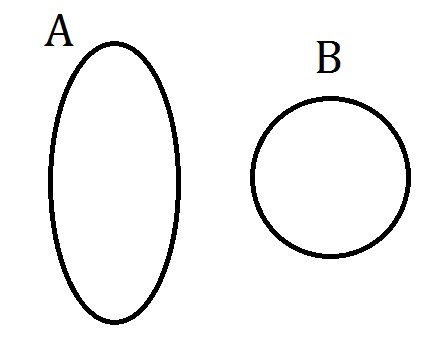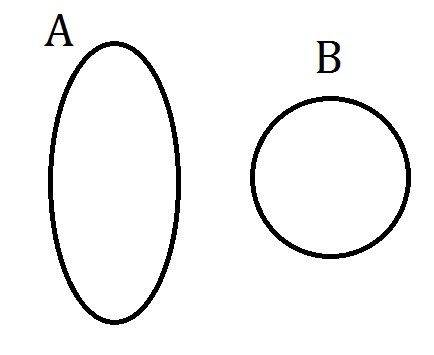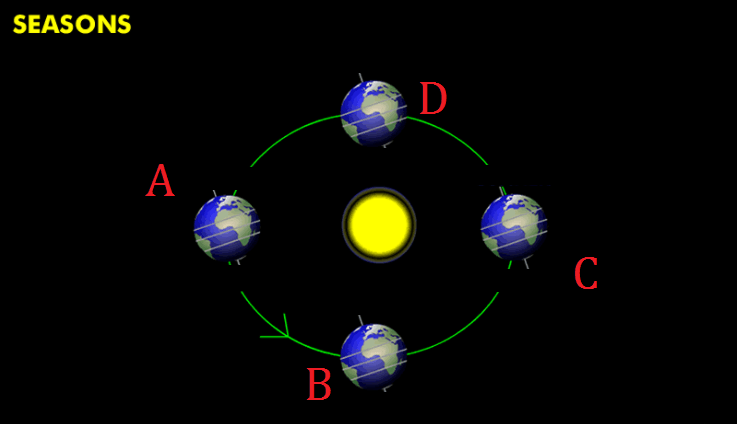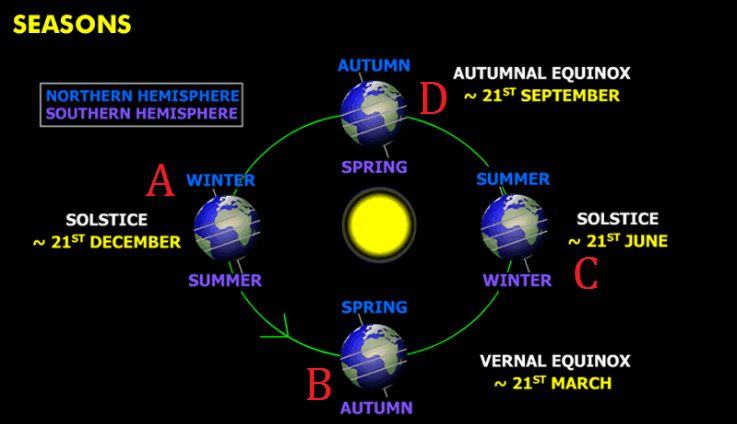Hours
Hours
Sunlight
Vocab
What is the relationship between the number of daylight hours and temperatures? Finish the sentences below to answer this question:
1. The more daylight hours we have the _________ temperatures we have.
2. The less daylight hours we have the _________ temperatures we have.
1. warmer
2. colder
What is the relationship between the amount of direct sunlight and temperatures? Finish the sentences below to answer this question:
1. The more direct sunlight we have the _________ temperatures we have.
2. The less direct sunlight we have the _________ temperatures we have.
1. warmer
2. colder
1. What is the difference between the Earth rotating and revolving?
2. Which of the two has an effect on our seasons?
1. rotating is spinning on its axis and is 1 day (24hrs). revolving is when the Earth is moving around the sun along its orbit and gives us 1 year.
2. Revolving
Whis of the four orbits is the correct shape of Earth's orbit? (remember the view is from the top down)

Orbit A
What would happen to the Earth if the sun stopped producing heat energy?
The Earth would begin to freeze because the Sun is the source of most of our heat energy on Earth.
Is Ms. Stager right handed or left handed?
(you have a 50/50 shot)
Right handed
Does the Earth rotating have an affect on the number of daylight hours a certain location receives?
Yes or No and BRIEFLY explain your answer
1. No because rotating just gives us day and night
1. What is it called when the North and South poles have 24 hours of daylight during a certain time of the year?
2. Why is it that the North and South Poles, who have 24 hours of daylight, are not the hottest places on Earth?
1. White nights
2. They don't have enough direct sunlight to become the hottest place on Earth
What gives us day and night?
Rotating
Which shape has their foci points further apart from one another?

A

What would happen if the Earth was not tilted?
We would just have the same “season” all year long because we would not have a change in the amount of direct sunlight or the number of daylight hours.
Do I have a pet?
Yes or No and if so what kind
No I don't but if I did it would be a dog
In the photo the Earth has been paused at one point on its orbit. Which hemisphere is receiving more hours of daylight and which hemisphere is receiving less hours of daylight?

1. More hours of daylight =
2. Less hours of daylight =
1. More hours of daylight = Southern
2. Less hours of daylight = Northern

As you move further from the equator on the Earth what starts to happen to the amount of direct sunlight you get?
The further away from the equator you get the less direct sunlight you will receive because the Earth is a sphere and is tilted on its axis.
What do latitude lines tell us?
What do longitude lines tell us?
Latitude =
Longitude =
Latitude lines tell us how far north or how far south we are form the equator.
Longitude lines tell us how far east or west we are from the prime meridian.
1. During what season are we the closest we will ever be to the sun along our orbit?
2. During what season are we the furthest we will ever be to the sun along our orbit?
1. Winter
2. Summer
What would happen if the Earth stopped revolving but continued to rotate.
We would just have the same “season” all year long because we would not have a change in the amount of direct sunlight or the number of daylight hours.
How old am I? (Hopefully you get it close!)
31
Write the letter or letters that go with the answers to the questions below.

1.Which locations in the photo are the equinoxes along Earth's orbit?
2. Which locations in the photo are the solstices along Earth's orbit?
BONUS POINTS...for giving more specifics about which points are the winter and summer solstices and which are the spring and fall equinoxes.

1. As the northern hemisphere is moving into winter does the amount of direct sunlight increase or decrease for the NORTHERN hemisphere?
2. As the northern hemisphere is moving into winter does the amount of direct sunlight increase or decrease for the SOUTHERN hemisphere?
1. Decrease
2. Increase
What does the astronomical unit represent/tell us?
(make sure to be specific and give numbers in your answer)
it is the unit of measurement that is the same as the distance from the Earth to the Sun and is 93 million miles
Why do people often mistake orbit C for the correct shape of Earth's orbit?

They forget that the view is from the top down so our perspective is different than how they are used to seeing it drawn in books and on posters.
What would happen if the shape of Earth's orbit was actually orbit D?

The whole Earth would get very hot during part of the year and very very cold during part of the year. Everything on Earth would change.
Where did I go to college and what sport did I play there?
(hint: it is the same sport that i currently coach)
University of New Hampshire (UNH)
Lacrosse
For those of us in Ipswich, why is our 1st month of Winter in December but the LEAST amount of daylight hours starts in November?
It takes time for the Earth to cool down. As we start losing our daylight hours in November we start to have less time during the day to heat up and more time at night to cool down so our temperatures start to go down.
Put these locations in order from the most amount of direct sunlight to the least amount of direct sunlight. (Most being #1 and Least being #4)
a. 58oN
b. 34oS
c. 4oS
d. 28oN
1. c. 4oS - MOST
2. d. 28oN
3. b. 34oS
4. a. 58oN - LEAST
What is the difference between an ellipse and a circle?
A circle is a shape drawn around two foci points where the foci points are one on top of each other. An ellipse is a shape draw around two foci points where the foci points are a certain distance apart.
Does how close or how far away we are from the sun have an affect on why we have seasons?
BRIEFLY explain how you know.
How close or how far away we are along our orbit does not have an affect on why we have seasons. If that were the true then when we are closest to the sun along our orbit we should have summer but in reality we are the furthest we will ever be from the sun along our orbit during summer.
What would happen to our day and night cycle if the Earth stopped rotating but continued to revolve?
We would have what we would consider 24 hours of day and night over the course of a whole year.
What activity was I doing when I destroyed my ankle and had to get surgery?
Trail Running/Hiking